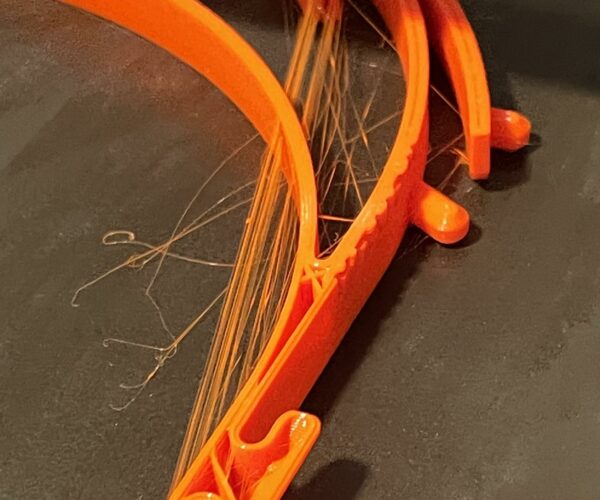Stringing issues with prusament
I've had my i3 Mk3s set up for a couple of weeks now, and I had great results using the basic silver PLA that shipped with the printer. I've just started printing with some prusament and I'm getting a lot of stringing on just about everything I print, and haven't been able to resolve it. The attached was printed at 207 with 1.2mm retraction and looks no different to something printed with the stock settings or at 220, and layer height doesn't seem to be a factor either - while the pictured model is fairly detailed on top with 0.07mm layer height the pictured base is at 0.2 and it seems to happen with just about everything I print if there's a lot of retracted movement involved.


RE: Stringing issues with prusament
Have you tried drying the filament in a box with dessicant or an oven? maybe turning off z-hop might help too.
RE: Stringing issues with prusament
1.2 mm seems high. In any case, some filament strings. So far, no one has presented a unified solution that cures all cases. No retraction and no z-hop reduces strings inside a part, setting do-not-cross-perimeters does the same. Drying some filaments seems to help, but moisture in a new freshly opened spool is unlikely.
Prusa spent a fair bit of time experimenting with settings for the printer and their filaments to provide a very solid baseline. Deviating from those presets - I have found - lead to worse results. Except for a slight nozzle temp modification(+/-10c) or bed modification (+10c for larger parts that may warp), I keep it simple. I have yet to find a case where changing default retraction has helped.
You may want to invest in a good dual or triple temp heat gun, makes the strings go away with a a single waft of hot air.
ps: layer 1 looks a little high; and your bridging looks very good.
RE: Stringing issues with prusament
Thanks for your comments. I probably wasn't clear, I do usually leave the settings at the default, the additional retraction was just an attempt at trying to reducing the stringing, with no effect - the default 0.8mm retraction leaves the same stringing on the print.
I've tried applying a heat gun at 200C to a couple of prints as suggested in the 'stringing' guide but thus far it seems to have had no effect on the stringing by the time it starts to soften and warp the print. I'll try experimenting with different temperatures to see if anything works there.
I guess it's just frustrating since I was getting such great results with the cheaper silver included with the printer and then the really good quality filament is giving me these issues.
Re drying - I haven't tried drying it, but this is literally fresh out of the vacuum sealed package, I assumed it was ready to go and didn't need drying before use?
RE: Stringing issues with prusament
As you can read in my thread I have similar problems with stringing.
The advice to use a head gun is in my opinion just a joke, we are talking about a 760,- € printer and the solution is to use a head gun 🤣
Stringing issues with Prusament
I opened a brand new roll of Prusament PETG yesterday and printed a Prusa Pro face shield with Prusa's Gcode. It was a virtually perfect print, with only a few small gossamer strings. One of the best PETG prints I've ever done.
I left the filament open to room air on the printer overnight. (Temperature 17 C RH 60%). Eight hours later I printed the same gcode with the same roll, and got severe stringing with whole clusters of strong spider webs along the travel lines between parts. I've cleaned the nozzle including with cleaning filament, and I have good flow from the nozzle, but still getting the severe stringing. I can't believe that the filament could have deteriorated overnight, but I'll heat dry it for a few hours and see if it gets better.
In really high humidity filament can absorb too much water before a print finishes - with some types of nylon 8 hour prints become impossible unless the filament is led direct from the dryer. PETG is usually OK for about 30 hours at worst. PLA takes about three days.
Here we are going into winter and using some heating, I expect my humidity problems to reduce significantly until spring.
The advice to use a head gun is in my opinion just a joke, we are talking about a 760,- € printer and the solution is to use a head gun
This is nothing to do with the printer. A heat gun is a quick and dirty way to deal with fine stringing. Fine abrasive is a good alternative.
Cheerio,
RE:
I dried the filament in a food dryer at 45C for 2 hours. The next setting up on my food dryer is 85C which is too hot. Huge improvement in the stringing. I'll now dry if for longer.
I also checked the humidity overnight - up to 85% Temp 17C. Now I'm looking at using a drying box during and after PETG prints.
